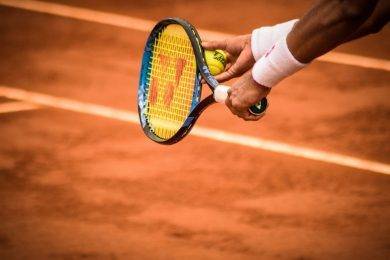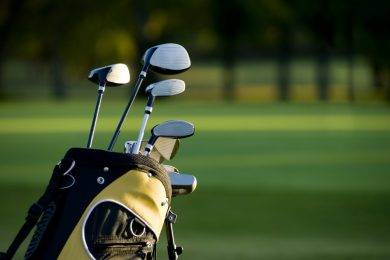Error: Contact form not found.
Tennis is a rare individual sport that rewards constant growth. Whether you’re an amateur or advanced player, there’s always room to get better.
The thing is, regular practice and dedication often aren’t enough. The best way to improve your game is to use tactics that give you an advantage over your opponent. This includes controlling tempo, court positioning, ball placement, and more.
Looking to develop your tennis skills? Here are nine simple tips that may give you an edge in your next match.
1. Exploit Opponents’ Weaknesses
Every tennis match should include a short warm-up beforehand. Other than getting ready to play, you should use this time to study your opponent’s game. Hit various backhands and forehands to figure out how they return them.
Once you have a general idea of their weaknesses, consider your strategy. You can attack them from the get-go or try playing to their strengths first. The latter method is more effective at opening up their weaknesses.
Let’s say your opponent has a subpar backhand. Early in the match, you can try hitting forehands as hard as you can to make them uncomfortable. As soon as their backhand opens up, switch for an easy point.
2. Use Proper Footwork
In tennis, being in the right place to hit a shot well is an important skill. One thing to keep in mind is that all strokes start from the ground upward. Therefore, finding a consistent shot is all about allowing for easy weight transfer.
Before hitting a shot, make sure your weight is fully loaded on your back leg. That way, you can transfer that weight into your shot. Otherwise, you’re less likely to get your feet to the ball on time, which often results in having to reach.
3. Identify Your Pattern of Play
When it comes to playing tennis, being creative is often a hindrance. Most amateur players don’t think about the type of shots they’re trying to hit. What you should do focus on hitting shots that you know will work.
Most pro players stick to one or two patterns of play during a match as well. For example, Rafael Nadal prefers hitting forehand serves to start a play. This is a pattern that has worked for him very well in the past, so he keeps at it.
4. Watch Your Nutrition
Speaking of pro players, did you notice they always drink something at changeovers? Well, they don’t do that because they’re thirsty. This keeps them hydrated throughout the match, giving them the energy they need to win.
Amateur players should follow this example. A good general rule to follow is to drink on every changeover and have a snack on every other. Eating a small piece of a choco bar and taking a sip of an energy drink should be enough.
5. Set Up Your Serve
According to experts, the serve is the most important shot in tennis. Still, this doesn’t mean you should hit serves as hard as you can every time you have the chance. The more you wail on the ball, the more it hurts the rest of your game.
The better option is to focus on accuracy during your serve. When you set up your shot well, any added spin or speed you get from it are just bonuses. To learn more about how to develop a perfect tennis serve, click on that link.
6. Restring Your Racquet
One of the lesser-known tennis tips is to have your racquet strung by a pro. Most amateurs go to the store and pick the first racquet that catches their eye, which is wrong. You should know how to choose your perfect tennis racket.
If you spend a few more bucks to restring it, it will suit your style of play much better.
For instance, any slower player would benefit from a livelier string. The same applies to baseliners who can’t generate much power in their shots. To restring your racket, head to your local club and have one of the employees do it.
7. Play the Momentum of the Match
Lost a few games — or even a set — to someone you usually beat? Instead of rushing to get the lead back, slow down and adjust your momentum. The more you try to shift the odds in your favor, the less organized your game will be.
One thing that helps is taking the full 20 seconds between points to gather yourself. Of course, if you’re racking up points, you should do the opposite. Play quicker to keep the momentum up and put more pressure on your opponent.
8. Don’t Risk Too Much
Knowing how to play tennis is about knowing your limits. Sure, being aggressive and going for the line can bring you a few points. If you try to do it with every shot, though, you stop being aggressive and start being reckless.
Instead of risking your shots, go for a consistent approach. Aim for targets on the court where you think you can play a decent, clean shot. The better you get as a player, the easier it will be to pinpoint these opportunities.
9. Stretch, Stretch, Stretch
Stretching before a match is important, especially if you don’t tend to play well at the start. Both static and dynamic stretching can work. The former involves holding a pose, and the latter is all about loosening up through specific exercises.
Stretching helps because it decreases muscle and joint stiffness and allows free-flowing movement. In a fine motor skill sport such as tennis, this is a big help. Plenty of pro players have seen success after modifying their stretching regimen.
More on Improving Tennis Skills
If you struggle with sharpening your tennis skills, don’t panic! Tennis is one of the most difficult sports to learn, so any progress is a cause for celebration.
Here’s one final tip for the road: record some video of your game. When you watch it, you’ll likely notice several things you can improve on. Video analysis is a great way to fix issues such as hitting shots too deep or standing in the wrong place.
Looking for more tips for tennis players? Interested in learning the basics of another sport? Keep reading our Sports section for more information on these topics!











